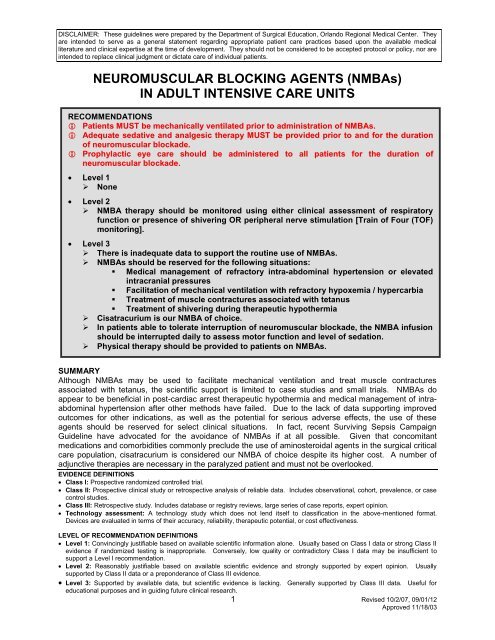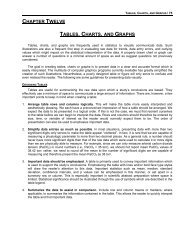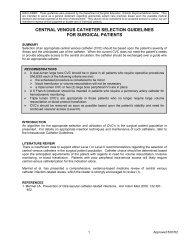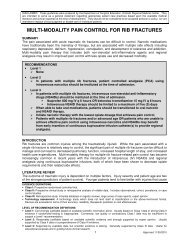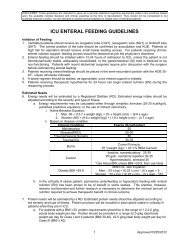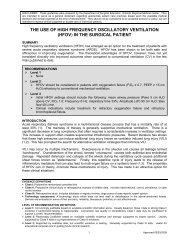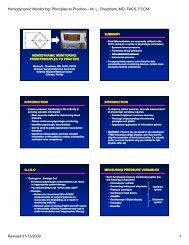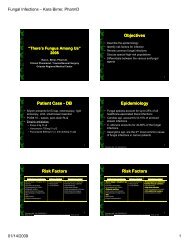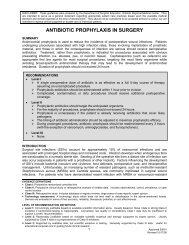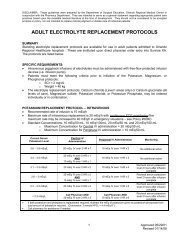Neuromuscular Blocking Agents in the Adult ICU
Neuromuscular Blocking Agents in the Adult ICU
Neuromuscular Blocking Agents in the Adult ICU
Create successful ePaper yourself
Turn your PDF publications into a flip-book with our unique Google optimized e-Paper software.
DISCLAIMER: These guidel<strong>in</strong>es were prepared by <strong>the</strong> Department of Surgical Education, Orlando Regional Medical Center. They<br />
are <strong>in</strong>tended to serve as a general statement regard<strong>in</strong>g appropriate patient care practices based upon <strong>the</strong> available medical<br />
literature and cl<strong>in</strong>ical expertise at <strong>the</strong> time of development. They should not be considered to be accepted protocol or policy, nor are<br />
<strong>in</strong>tended to replace cl<strong>in</strong>ical judgment or dictate care of <strong>in</strong>dividual patients.<br />
NEUROMUSCULAR BLOCKING AGENTS (NMBAs)<br />
IN ADULT INTENSIVE CARE UNITS<br />
RECOMMENDATIONS<br />
Patients MUST be mechanically ventilated prior to adm<strong>in</strong>istration of NMBAs.<br />
Adequate sedative and analgesic <strong>the</strong>rapy MUST be provided prior to and for <strong>the</strong> duration<br />
of neuromuscular blockade.<br />
Prophylactic eye care should be adm<strong>in</strong>istered to all patients for <strong>the</strong> duration of<br />
neuromuscular blockade.<br />
Level 1<br />
‣ None<br />
Level 2<br />
‣ NMBA <strong>the</strong>rapy should be monitored us<strong>in</strong>g ei<strong>the</strong>r cl<strong>in</strong>ical assessment of respiratory<br />
function or presence of shiver<strong>in</strong>g OR peripheral nerve stimulation [Tra<strong>in</strong> of Four (TOF)<br />
monitor<strong>in</strong>g].<br />
Level 3<br />
‣ There is <strong>in</strong>adequate data to support <strong>the</strong> rout<strong>in</strong>e use of NMBAs.<br />
‣ NMBAs should be reserved for <strong>the</strong> follow<strong>in</strong>g situations:<br />
• Medical management of refractory <strong>in</strong>tra-abdom<strong>in</strong>al hypertension or elevated<br />
<strong>in</strong>tracranial pressures<br />
• Facilitation of mechanical ventilation with refractory hypoxemia / hypercarbia<br />
• Treatment of muscle contractures associated with tetanus<br />
• Treatment of shiver<strong>in</strong>g dur<strong>in</strong>g <strong>the</strong>rapeutic hypo<strong>the</strong>rmia<br />
‣ Cisatracurium is our NMBA of choice.<br />
‣ In patients able to tolerate <strong>in</strong>terruption of neuromuscular blockade, <strong>the</strong> NMBA <strong>in</strong>fusion<br />
should be <strong>in</strong>terrupted daily to assess motor function and level of sedation.<br />
‣ Physical <strong>the</strong>rapy should be provided to patients on NMBAs.<br />
SUMMARY<br />
Although NMBAs may be used to facilitate mechanical ventilation and treat muscle contractures<br />
associated with tetanus, <strong>the</strong> scientific support is limited to case studies and small trials. NMBAs do<br />
appear to be beneficial <strong>in</strong> post-cardiac arrest <strong>the</strong>rapeutic hypo<strong>the</strong>rmia and medical management of <strong>in</strong>traabdom<strong>in</strong>al<br />
hypertension after o<strong>the</strong>r methods have failed. Due to <strong>the</strong> lack of data support<strong>in</strong>g improved<br />
outcomes for o<strong>the</strong>r <strong>in</strong>dications, as well as <strong>the</strong> potential for serious adverse effects, <strong>the</strong> use of <strong>the</strong>se<br />
agents should be reserved for select cl<strong>in</strong>ical situations. In fact, recent Surviv<strong>in</strong>g Sepsis Campaign<br />
Guidel<strong>in</strong>e have advocated for <strong>the</strong> avoidance of NMBAs if at all possible. Given that concomitant<br />
medications and comorbidities commonly preclude <strong>the</strong> use of am<strong>in</strong>osteroidal agents <strong>in</strong> <strong>the</strong> surgical critical<br />
care population, cisatracurium is considered our NMBA of choice despite its higher cost. A number of<br />
adjunctive <strong>the</strong>rapies are necessary <strong>in</strong> <strong>the</strong> paralyzed patient and must not be overlooked.<br />
EVIDENCE DEFINITIONS<br />
Class I: Prospective randomized controlled trial.<br />
Class II: Prospective cl<strong>in</strong>ical study or retrospective analysis of reliable data. Includes observational, cohort, prevalence, or case<br />
control studies.<br />
Class III: Retrospective study. Includes database or registry reviews, large series of case reports, expert op<strong>in</strong>ion.<br />
Technology assessment: A technology study which does not lend itself to classification <strong>in</strong> <strong>the</strong> above-mentioned format.<br />
Devices are evaluated <strong>in</strong> terms of <strong>the</strong>ir accuracy, reliability, <strong>the</strong>rapeutic potential, or cost effectiveness.<br />
LEVEL OF RECOMMENDATION DEFINITIONS<br />
Level 1: Conv<strong>in</strong>c<strong>in</strong>gly justifiable based on available scientific <strong>in</strong>formation alone. Usually based on Class I data or strong Class II<br />
evidence if randomized test<strong>in</strong>g is <strong>in</strong>appropriate. Conversely, low quality or contradictory Class I data may be <strong>in</strong>sufficient to<br />
support a Level I recommendation.<br />
Level 2: Reasonably justifiable based on available scientific evidence and strongly supported by expert op<strong>in</strong>ion. Usually<br />
supported by Class II data or a preponderance of Class III evidence.<br />
Level 3: Supported by available data, but scientific evidence is lack<strong>in</strong>g. Generally supported by Class III data. Useful for<br />
educational purposes and <strong>in</strong> guid<strong>in</strong>g future cl<strong>in</strong>ical research.<br />
1 Revised 10/2/07, 09/01/12<br />
Approved 11/18/03
INTRODUCTION<br />
<strong>Neuromuscular</strong> block<strong>in</strong>g agents (NMBAs) should be considered an <strong>in</strong>tervention of last resort due to <strong>the</strong><br />
multiple complications associated with <strong>the</strong>ir use. These agents are classified based upon <strong>the</strong>ir structure,<br />
mechanism of action, and pharmacok<strong>in</strong>etic properties. Structurally, NMBAs have ei<strong>the</strong>r an<br />
am<strong>in</strong>osteroidal or benzylisoqu<strong>in</strong>ol<strong>in</strong>ium nucleus. Mechanistically, <strong>the</strong>y are classified as ei<strong>the</strong>r<br />
depolariz<strong>in</strong>g or non-depolariz<strong>in</strong>g. Depolariz<strong>in</strong>g agents b<strong>in</strong>d to and activate nicot<strong>in</strong>ic acetylchol<strong>in</strong>e<br />
receptors result<strong>in</strong>g <strong>in</strong> depolarization of <strong>the</strong> postsynaptic membrane of striated muscle. Succ<strong>in</strong>ylchol<strong>in</strong>e is<br />
<strong>the</strong> only depolariz<strong>in</strong>g agent. Outside of rapid sequence <strong>in</strong>tubation (RSI), it has limited application <strong>in</strong> <strong>the</strong><br />
<strong>ICU</strong> sett<strong>in</strong>g due to its short half-life. Non-depolariz<strong>in</strong>g agents also b<strong>in</strong>d to acetylchol<strong>in</strong>e receptors, but<br />
<strong>in</strong>stead of activat<strong>in</strong>g <strong>the</strong>m <strong>the</strong>y act as competitive antagonists. Pharmacok<strong>in</strong>etically, NMBAs differ <strong>in</strong> <strong>the</strong>ir<br />
duration of action and route of elim<strong>in</strong>ation. Additionally, differences exist <strong>in</strong> <strong>the</strong> degree of histam<strong>in</strong>e<br />
release, vagal block, risk of prolonged blockade, and cost.<br />
AMINOSTEROIDAL AGENTS<br />
BENZYLISOQUINOLINIUM<br />
AGENT<br />
NMBA<br />
Pancuronium<br />
Vecuronium<br />
Cisatracurium<br />
(Pavulon )<br />
(Norcuron )<br />
(Nimbex )<br />
Initial dose (mg/kg) 0.06-0.1 0.08-0.1 0.1-0.2<br />
Duration (m<strong>in</strong>) 90-100 35-45 45-60<br />
Infusion dose<br />
(g/kg/m<strong>in</strong>)<br />
1-2 0.8-1.2 2.5-3<br />
Recovery (m<strong>in</strong>) 120-180 45-60 90<br />
% Renal excretion 45-70 50 Hoffman elim<strong>in</strong>ation<br />
Renal failure Increased effect Increased effect No change<br />
% Biliary excretion 10-15 35-50 Hoffman elim<strong>in</strong>ation<br />
Hepatic failure Mild <strong>in</strong>creased effect<br />
Variable, mild <strong>in</strong>creased<br />
effect<br />
M<strong>in</strong>imal to no change<br />
Active metabolites Yes Yes No<br />
Histam<strong>in</strong>e release<br />
(hypotension)<br />
No No No<br />
Vagal block<br />
(tachycardia)<br />
Modest to marked No No<br />
Prolonged <strong>ICU</strong><br />
block<br />
Yes Yes Rare<br />
Relative Cost $ $$ $$$<br />
Adapted from Murray et al. Crit Care Med 2002; 30:142-56<br />
LITERATURE REVIEW<br />
The cl<strong>in</strong>ical practice guidel<strong>in</strong>es developed by <strong>the</strong> American College of Critical Care Medic<strong>in</strong>e of <strong>the</strong><br />
Society of Critical Care Medic<strong>in</strong>e provide a detailed review of issues related to <strong>the</strong> susta<strong>in</strong>ed use of<br />
NMBAs <strong>in</strong> critically ill patients (1). The physiology of <strong>the</strong> neuromuscular receptor and pharmacology of<br />
NMBAs used <strong>in</strong> <strong>the</strong> <strong>ICU</strong> sett<strong>in</strong>g are reviewed. Additionally, methods of monitor<strong>in</strong>g and complications are<br />
discussed and recommendations are provided. An evidence-based review focus<strong>in</strong>g on <strong>the</strong> use of NMBAs<br />
<strong>in</strong> critically ill septic patients provides recommendations specific to this population (2).<br />
Selected studies address<strong>in</strong>g monitor<strong>in</strong>g and complications are discussed below.<br />
Monitor<strong>in</strong>g<br />
A prospective, randomized, controlled <strong>in</strong>vestigation was conducted <strong>in</strong> 77 critically ill medical patients to<br />
compare outcomes between two different monitor<strong>in</strong>g methods of neuromuscular blockade (3).<br />
Vecuronium doses were <strong>in</strong>dividualized by peripheral nerve stimulation (TOF) <strong>in</strong> <strong>the</strong> treatment group and<br />
by standard cl<strong>in</strong>ical assessment <strong>in</strong> <strong>the</strong> control group. Although TOF monitor<strong>in</strong>g was performed <strong>in</strong> <strong>the</strong><br />
control group, <strong>the</strong> nurs<strong>in</strong>g and housestaff were bl<strong>in</strong>ded to <strong>the</strong> results and made dosage adjustments<br />
accord<strong>in</strong>g to a protocol. The mean TOF value at drug discont<strong>in</strong>uation was significantly lower <strong>in</strong> <strong>the</strong><br />
standard cl<strong>in</strong>ical assessment group compared to <strong>the</strong> TOF group. There was less drug used to achieve<br />
2 Revised 10/2/07, 09/01/12<br />
Approved 11/18/03
90% blockade (TOF=1) <strong>in</strong> <strong>the</strong> patients monitored by TOF compared to those monitored by standard<br />
cl<strong>in</strong>ical assessment. The mean <strong>in</strong>fusion rate and cumulative amount of drug used were also significantly<br />
lower <strong>in</strong> <strong>the</strong> TOF group. Recovery to a TOF of 4/4 and return of spontaneous ventilation were<br />
significantly faster <strong>in</strong> <strong>the</strong> TOF group. The <strong>in</strong>cidence of prolonged paralysis was significantly higher <strong>in</strong> <strong>the</strong><br />
standard cl<strong>in</strong>ical assessment group. Overall, 71% of patients (<strong>in</strong>clud<strong>in</strong>g patients from both groups) had<br />
abnormal neurologic exam<strong>in</strong>ations follow<strong>in</strong>g discont<strong>in</strong>uation of vecuronium. (Class I)<br />
In ano<strong>the</strong>r trial, medical <strong>ICU</strong> patients receiv<strong>in</strong>g cont<strong>in</strong>uous cisatracurium were randomized to TOF<br />
monitor<strong>in</strong>g (n=16) or cl<strong>in</strong>ical assessment (n=14) (4). Cl<strong>in</strong>ical assessment consisted of adjust<strong>in</strong>g <strong>the</strong><br />
NMBA based on observed responses of <strong>the</strong> patient. Specifically, nurses monitored for patient-ventilator<br />
dyssynchrony def<strong>in</strong>ed as signs of “buck<strong>in</strong>g” and elevated mechanical ventilation peak pressures. Total<br />
absence of patient <strong>in</strong>itiated breaths was a goal of cl<strong>in</strong>ical assessment only for those patients undergo<strong>in</strong>g<br />
<strong>in</strong>verse-ratio ventilation. Demographics were similar between groups and <strong>the</strong>re were no differences <strong>in</strong><br />
<strong>the</strong> total number of medications or medication type (corticosteroid, am<strong>in</strong>oglycoside, or cl<strong>in</strong>damyc<strong>in</strong>). In<br />
respect to <strong>the</strong> outcome measures of postparalytic recovery times, total time paralyzed before<br />
discont<strong>in</strong>uation of paralytic, total cisatracurium dose or episodes of prolonged paralysis, <strong>the</strong>re was no<br />
difference between groups. Additionally, no cases of prolonged paralysis syndrome or cl<strong>in</strong>ical evidence<br />
of acute myopathy were noted. (Class I)<br />
Complications<br />
There is an <strong>in</strong>creas<strong>in</strong>g body of literature report<strong>in</strong>g prolonged neuromuscular dysfunction follow<strong>in</strong>g <strong>the</strong> use<br />
of NMBAs. This can result from ei<strong>the</strong>r drug accumulation or <strong>the</strong> development of acute quadriplegic<br />
myopathy syndrome (AQMS). AQMS <strong>in</strong>cludes critical illness myopathy, myopathy with selective loss of<br />
thick (myos<strong>in</strong>) filaments, and acute necrotiz<strong>in</strong>g myopathy of <strong>in</strong>tensive care (5). It is characterized by<br />
acute paresis, myonecrosis, and abnormal electromyography f<strong>in</strong>d<strong>in</strong>gs (1). Sensory function generally<br />
rema<strong>in</strong>s <strong>in</strong>tact. A number of factors have been reported to potentiate <strong>the</strong> development of prolonged<br />
neuromuscular dysfunction, most notably <strong>the</strong> concomitant use of corticosteroids. Although most reports<br />
describe <strong>the</strong> use of high-dose corticosteroids <strong>in</strong> comb<strong>in</strong>ation with a steroid-based NMBA, <strong>the</strong><br />
benzylisoqu<strong>in</strong>ol<strong>in</strong>ium agents have also been implicated (6). One mechanism responsible for this drug<br />
<strong>in</strong>teraction is an additive decrease <strong>in</strong> thick filament prote<strong>in</strong>s (7). The follow<strong>in</strong>g table provides a list of<br />
antibiotics that may potentiate neuromuscular blockade when used <strong>in</strong> comb<strong>in</strong>ation with NMBAs.<br />
<br />
<br />
<br />
<br />
<br />
ANTIBIOTICS THAT MAY ENHANCE THE EFFECTS OF<br />
NONDEPOLARIZING NMBAs<br />
Am<strong>in</strong>oglycosides<br />
Cl<strong>in</strong>damyc<strong>in</strong><br />
Polymyx<strong>in</strong>s<br />
Colist<strong>in</strong><br />
Tetracycl<strong>in</strong>es<br />
3 Revised 10/2/07, 09/01/12<br />
Approved 11/18/03
REFERENCES<br />
1. Murray MJ, Cowen J, DeBlock H, et al. Cl<strong>in</strong>ical practice guidel<strong>in</strong>es for susta<strong>in</strong>ed neuromuscular<br />
blockade <strong>in</strong> <strong>the</strong> adult critically ill patient. Crit Care Med 2002; 30:142-156.<br />
2. Vender JS, Szokol JW, Murphy GS, et al. Sedation, analgesia, and neuromuscular blockade <strong>in</strong><br />
sepsis: An evidence-based review. Crit Care Med 2004; 32[Suppl.]:S554-S561.<br />
3. Rudis MI, Sikora CA, Angus E, et al. A prospective, randomized, controlled evaluation of peripheral<br />
nerve stimulation versus standard cl<strong>in</strong>ical dos<strong>in</strong>g of neuromuscular block<strong>in</strong>g agents <strong>in</strong> critically ill<br />
patients. Crit Care Med 1997; 25:575-583.<br />
4. Baumann MH, McAlp<strong>in</strong> BW, Brown K, et al. A prospective randomized comparison of tra<strong>in</strong>-of-four<br />
monitor<strong>in</strong>g and cl<strong>in</strong>ical assessment dur<strong>in</strong>g cont<strong>in</strong>uous <strong>ICU</strong> cisatracurium paralysis. Chest 2004;<br />
126:1267-1273.<br />
5. Hund E. Myopathy <strong>in</strong> critically ill patients. Crit Care Med 1999; 27:2544-2547.<br />
6. Marik PE. Doxacurium-corticosteroid acute myopathy: Ano<strong>the</strong>r piece to <strong>the</strong> puzzle. Crit Care Med<br />
1996; 24:1266-1267.<br />
7. Larsson L, Xiaopeng L, Edstrom L, et al. Acute quadriplegia and loss of muscle myos<strong>in</strong> <strong>in</strong> patients<br />
treated with nondepolariz<strong>in</strong>g neuromuscular block<strong>in</strong>g agents and corticosteroids: Mechanisms at <strong>the</strong><br />
cellular and molecular levels. Crit Care Med 2000; 28:34-45.<br />
8. Soga T, Nagao K, Sawano H, Yokoyama H, et al. Neurological Benefit of Therapeutic Hypo<strong>the</strong>rmia<br />
Follow<strong>in</strong>g Return of Spontaneous Circulation for Out-of-Hospital Non-Shockable Cardiac Arrest.<br />
Circulation July 20, 2012 [Epub ahead of pr<strong>in</strong>t]<br />
9. Puthucheary Z, Rawal J, Ratnayake G, Harridge S, Montgomery H, Hart N. <strong>Neuromuscular</strong><br />
Blockade and Skeletal Muscle Weakness <strong>in</strong> Critically Ill Patients: Time to Reth<strong>in</strong>k <strong>the</strong> Evidence<br />
American Journal of Respiratory and Critical Care M Medic<strong>in</strong>e May 1 2012 vol. 185 no. 9, 911-917.<br />
10. Malbra<strong>in</strong> ML, Cheatham ML, Kirkpatrick A, Sugrue M, Parr M, De Waele J, Balogh Z, Leppäniemi A, Olvera C,<br />
Ivatury R, D'Amours S, Wendon J, Hillman K, Johansson K, Kolkman K, Wilmer A. Results from <strong>the</strong> International<br />
Conference of Experts on Intra-abdom<strong>in</strong>al Hypertension and Abdom<strong>in</strong>al Compartment Syndrome. I. Def<strong>in</strong>itions.<br />
2006; 32(11):1722-32.<br />
Surgical Critical Care Evidence-Based Medic<strong>in</strong>e Guidel<strong>in</strong>es Committee<br />
Primary Reviewer: Joseph Ibrahim, MD<br />
Editor: Michael L. Cheatham, MD<br />
Last revision date: September 1, 2012<br />
Please direct any questions or concerns to: mailto:webmaster@surgicalcriticalcare.net<br />
4 Revised 10/2/07, 09/01/12<br />
Approved 11/18/03


